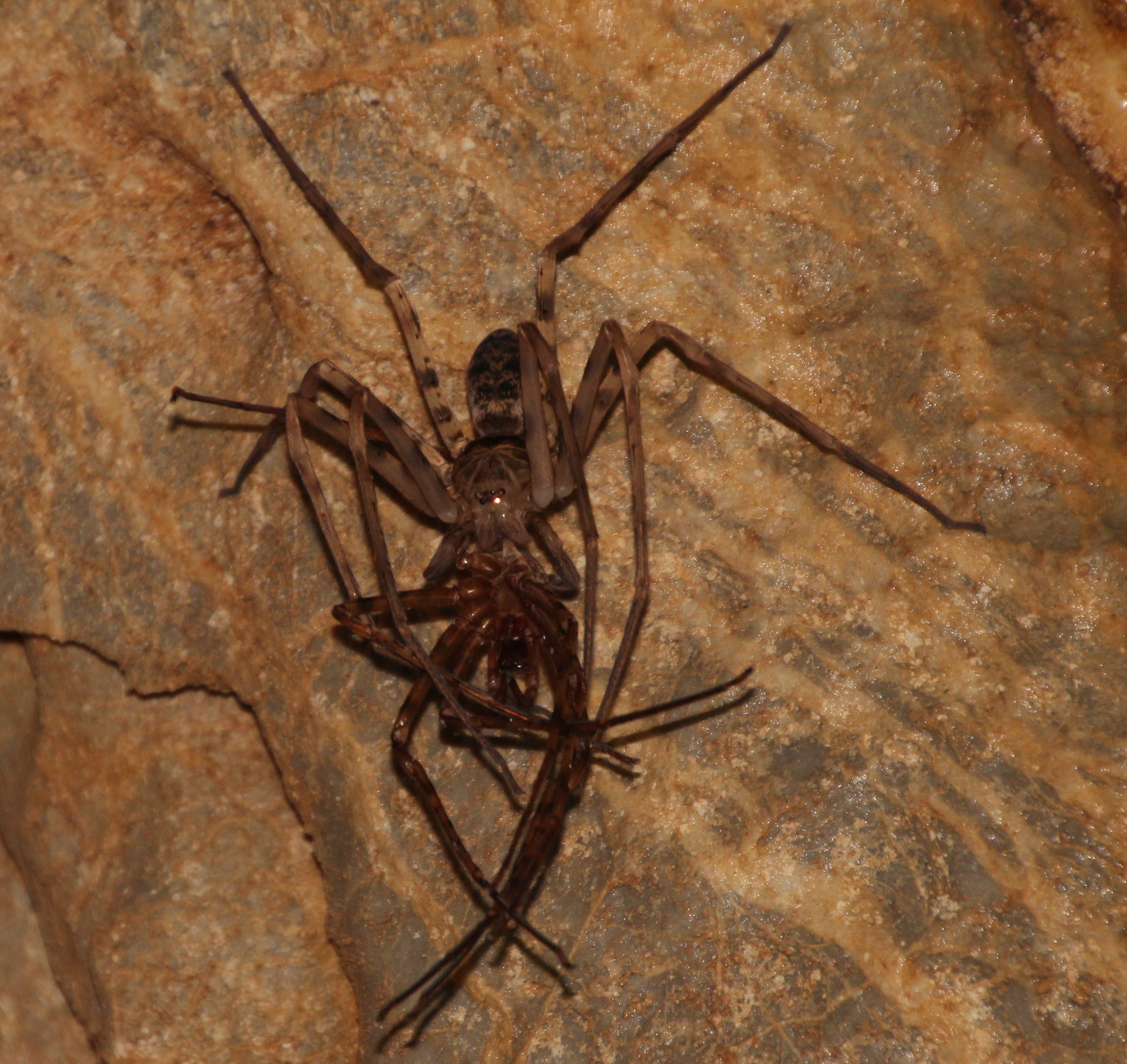Giant Huntsman Spider on:
[Wikipedia]
[Google]
[Amazon]
The giant huntsman spider (''Heteropoda maxima'') is a

species
A species () is often defined as the largest group of organisms in which any two individuals of the appropriate sexes or mating types can produce fertile offspring, typically by sexual reproduction. It is the basic unit of Taxonomy (biology), ...
of the huntsman spider
Huntsman spiders, members of the family Sparassidae (formerly Heteropodidae), catch their prey by hunting rather than in webs. They are also called giant crab spiders because of their size and appearance. Larger species sometimes are referred to ...
family Sparassidae found in Laos
Laos, officially the Lao People's Democratic Republic (LPDR), is the only landlocked country in Southeast Asia. It is bordered by Myanmar and China to the northwest, Vietnam to the east, Cambodia to the southeast, and Thailand to the west and ...
. It is considered the world's largest spider by leg span, which can reach up to .
Description
The coloration is yellowish-brown with several irregularly distributed dark spots on the rear half. The legs have wide dark bands before the first bend. Like all huntsman spiders, the legs of the giant huntsman spider are long compared to the body, and twist forward in a crab-like fashion. Apart from its size, the ''H. maxima'' can be distinguished from other species of ''Heteropoda'' by genital characteristics. On males, the cymbium is at least three times longer than thetegulum
The two palpal bulbs – also known as palpal organs and genital bulbs – are the copulatory organs of a male spider. They are borne on the last segment of the pedipalps (the front "limbs" of a spider), giving the spider an appearance often desc ...
. The female is distinguished by a characteristically shaped epigyneal field with two anterior directed bands, and the course of their internal ducts.
The giant huntsman spider is the largest member of the family Sparassidae, boasting a leg-span, and body-length. The largest known member of the Sparassidae
Huntsman spiders, members of the family Sparassidae (formerly Heteropodidae), catch their prey by hunting rather than in webs. They are also called giant crab spiders because of their size and appearance. Larger species sometimes are referred to ...
known prior to the discovery of ''H. maxima'' was the Australian ''Beregama aurea
''Beregama aurea'', sometimes called the golden huntsman, is a species of spider endemic to Queensland and parts of New South Wales, Australia. It is a member of the genus ''Beregama'' of huntsman spiders.
Description
This species closely r ...
'' (L. Koch, 1875) with a body length of about . (Other relatively large members of Sparassidae have been discovered in recent years, including '' Cerbalus aravaensis'', the largest in the Middle East).
Taxonomy and naming
''Heteropoda maxima'' was first described in 2001 by Peter Jäger, after being discovered in a cave inLaos
Laos, officially the Lao People's Democratic Republic (LPDR), is the only landlocked country in Southeast Asia. It is bordered by Myanmar and China to the northwest, Vietnam to the east, Cambodia to the southeast, and Thailand to the west and ...
. Over a thousand new species of plant and animal were found between 1997 and 2007 in the Greater Mekong Subregion
The Greater Mekong Subregion, (GMS) or just Greater Mekong, is a trans-national region of the Mekong River basin in Southeast Asia. The region is home to more than 300 million people. It came into being with the launch of a development program i ...
.
A representative of the World Wide Fund for Nature
The World Wide Fund for Nature (WWF) is a Swiss-based international non-governmental organization founded in 1961 that works in the field of wilderness preservation and the reduction of human impact on the environment. It was formerly named th ...
stated that "some of these species really have no business being recently discovered", suggesting that it is surprising for such a large species to go undiscovered for so long.
Distribution and habitat
The giant huntsman spider is found inLaos
Laos, officially the Lao People's Democratic Republic (LPDR), is the only landlocked country in Southeast Asia. It is bordered by Myanmar and China to the northwest, Vietnam to the east, Cambodia to the southeast, and Thailand to the west and ...
, and is believed to be a cave dweller because of its pale colour, long legs and special hairs on the second foot of the male. There is no apparent reduction of the eyes, possibly because the species lives near cave entrances.
Cannibalism
Florian and Diana Schnös discovered cannibalism within the species of giant huntsman spiders in a cave near Vang Vieng inLaos
Laos, officially the Lao People's Democratic Republic (LPDR), is the only landlocked country in Southeast Asia. It is bordered by Myanmar and China to the northwest, Vietnam to the east, Cambodia to the southeast, and Thailand to the west and ...
. Female individuals may eat male individuals after mating, a characteristic more commonly associated with the genus ''Latrodectus
''Latrodectus'' is a broadly distributed genus of spiders with several species that are commonly known as the true widows. This group is composed of those often loosely called black widow spiders, brown widow spiders, and similar spiders. However ...
'', the ''true widows,'' although it is considered normal spider behavior.

See also
*Goliath birdeater
The Goliath birdeater (''Theraphosa blondi'') belongs to the tarantula
Tarantulas comprise a group of large and often hairy spiders of the family Theraphosidae. , 1,100 species have been identified, with 166 genera. The term "tarantula" ...
(''Theraphosa blondi''), largest known spider in the world by mass
* '' Mongolarachne jurassica'', the largest known fossilized spider
* '' Cerbalus aravaensis'', a huntsman spider found in Israel and Jordan
References
Further reading
{{Taxonbar, from=Q114516 Sparassidae Endemic fauna of Laos Spiders of Asia Animal cannibalism